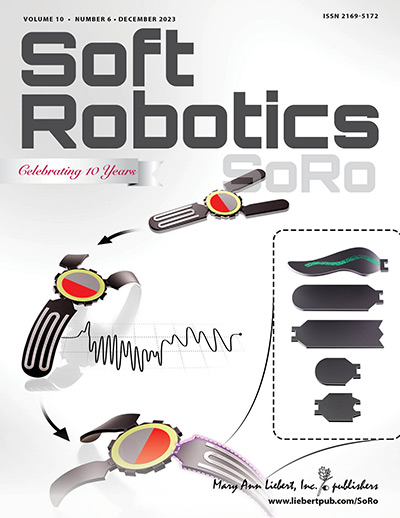可变刚度编织软活动纺织品和使用薄麦基本肌的机器人。
IF 6.1
2区 计算机科学
Q1 ROBOTICS
引用次数: 0
摘要
主动编织结构由于其特殊的身体顺应性、轻量化、长期稳定性和可编程架构而广泛应用于可穿戴和软机器人。虽然现有的主动编织结构已经成功地应用于执行器和传感器,但直接通过编织方法制造复杂的变刚度软机器人一直存在挑战。为了解决这个问题,我们从中国结技术中汲取灵感,利用薄麦基本肌肉编织各种可变刚度纺织品,包括柔性脊柱,柔性皮肤和双稳态结构,以及创新的软机器人,如软爬行机器人,软封闭抓取器和连续体模块。实验结果表明,所研制的变刚度纺织品的变刚度范围超过初始刚度的5.4倍。此外,我们还通过实验证明,编织软爬行机器人(重量为171 g)可以在铁磁表面上以666.7 mm/min的最大速度实现全方位运动;编织连续体模块(重49克)通过激活高刚度模式,可将外力对运动角度的影响降低65%以上;软封闭夹持器(重量为175克)可以举起14.7公斤重的物体,可变刚度功能可以将其多向承载能力提高约3.3倍。本研究为基于织造技术的复杂变刚度软机器人的发展提供了多种新的构型和思路。本文章由计算机程序翻译,如有差异,请以英文原文为准。
Variable Stiffness Woven Soft Active Textiles and Robots Using Thin McKibben Muscle.
Active woven structures are extensively utilized in wearable and soft robotics due to their exceptional body compliance, lightweight nature, long-term stability, and programmable architectures. Although existing active woven structures have been successfully applied to actuators and sensors, the fabrication of intricate variable stiffness soft robots directly through weaving methods has consistently posed challenges. To address this issue, we draw inspiration from the Chinese knot technique and employ thin McKibben muscles to weave a variety of variable stiffness textiles, including a flexible spine, flexible skin, and a bistable structure, as well as innovative soft robots such as a soft crawling robot, a soft enclosed gripper, and a continuum module. Experimental results demonstrate that the variable stiffness range of the developed variable stiffness textiles exceeds 5.4 times that of the initial stiffness. Furthermore, we also experimentally demonstrate that the woven soft crawling robot (weighing 171 g) can achieve omnidirectional movement on an ferromagnetic surface at a maximum speed of 666.7 mm/min; the woven continuum module (weighing 49 g) can reduce the impact of external forces on the motion angle by over 65% by activating the high stiffness mode; the soft enclosed gripper (weighing 175 g) can lift objects weighing up to 14.7 kg, and the variable stiffness function can enhance its multi-directional bearing capacity by ∼3.3 times. This study offers various new configurations and ideas for the advancement of complex variable stiffness soft robots based on weaving technology.
求助全文
通过发布文献求助,成功后即可免费获取论文全文。
去求助
来源期刊

Soft Robotics
ROBOTICS-
CiteScore
15.50
自引率
5.10%
发文量
128
期刊介绍:
Soft Robotics (SoRo) stands as a premier robotics journal, showcasing top-tier, peer-reviewed research on the forefront of soft and deformable robotics. Encompassing flexible electronics, materials science, computer science, and biomechanics, it pioneers breakthroughs in robotic technology capable of safe interaction with living systems and navigating complex environments, natural or human-made.
With a multidisciplinary approach, SoRo integrates advancements in biomedical engineering, biomechanics, mathematical modeling, biopolymer chemistry, computer science, and tissue engineering, offering comprehensive insights into constructing adaptable devices that can undergo significant changes in shape and size. This transformative technology finds critical applications in surgery, assistive healthcare devices, emergency search and rescue, space instrument repair, mine detection, and beyond.
 求助内容:
求助内容: 应助结果提醒方式:
应助结果提醒方式:


